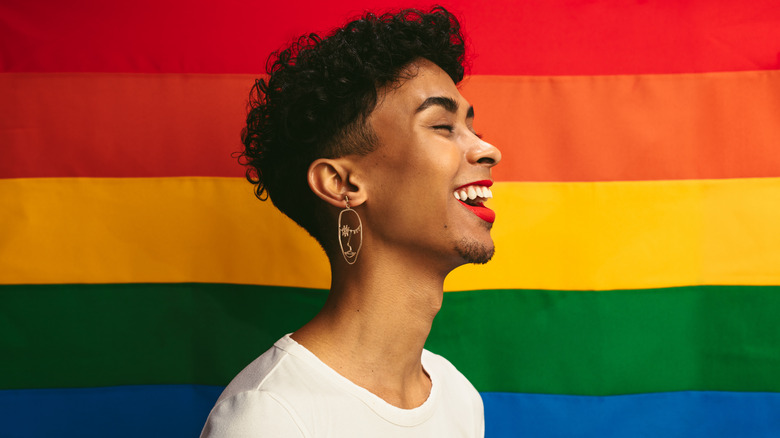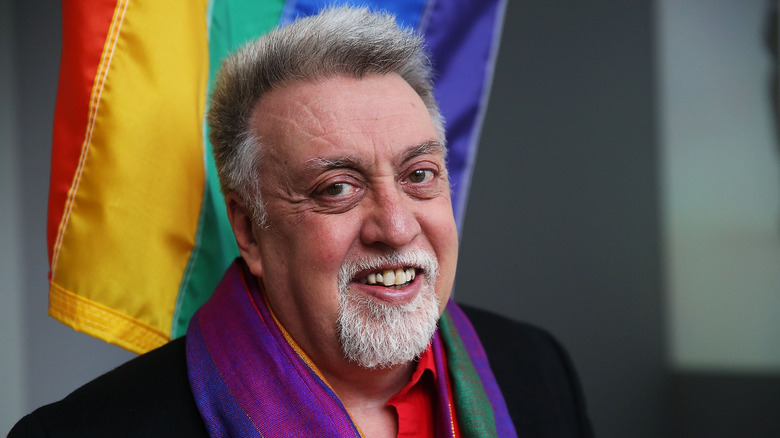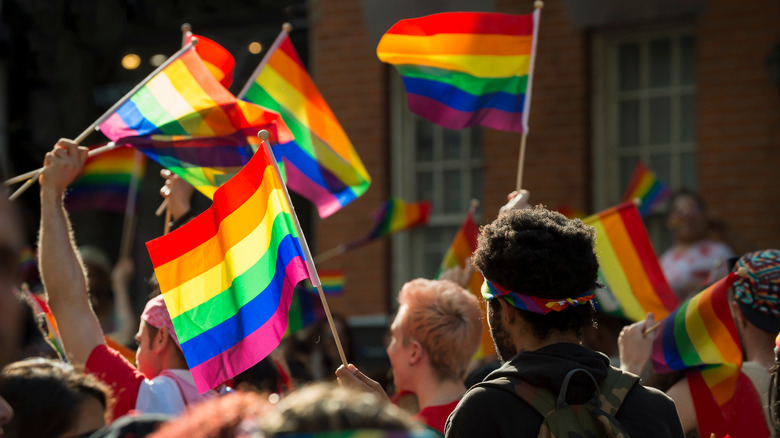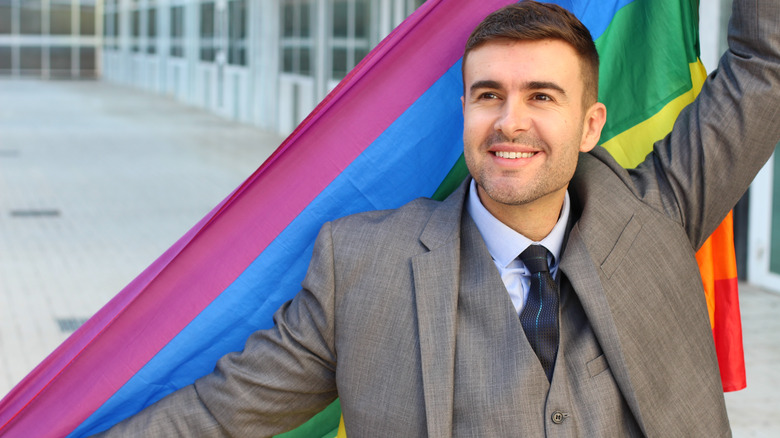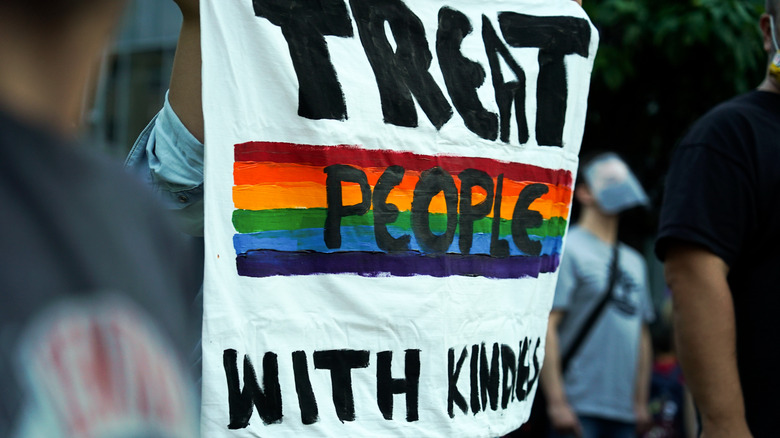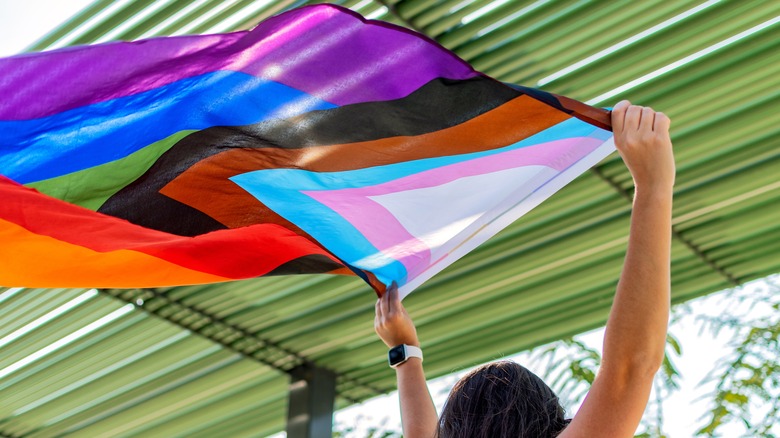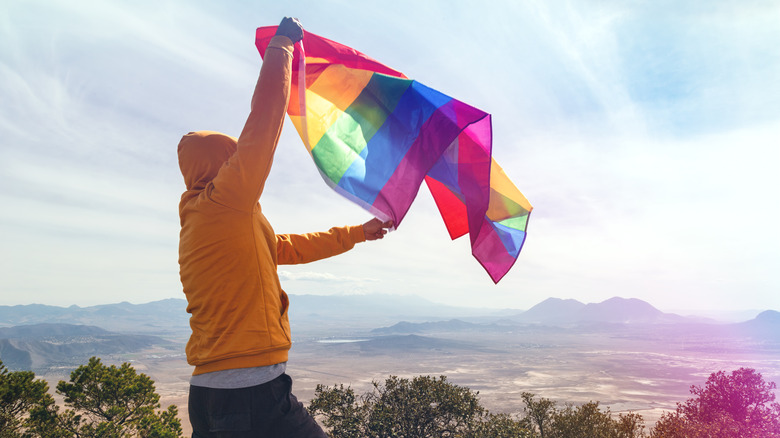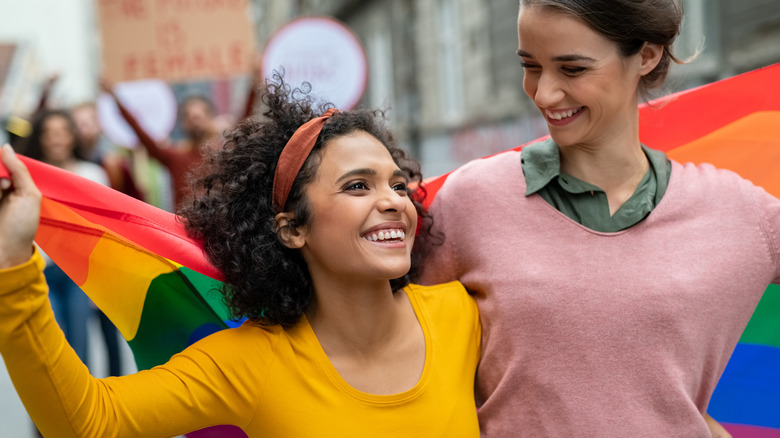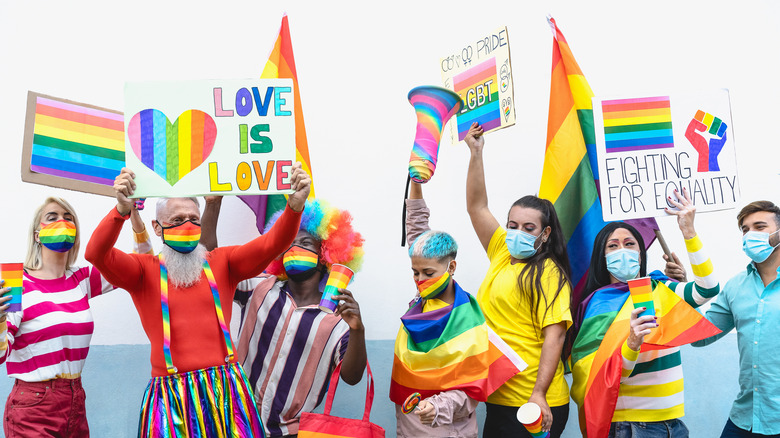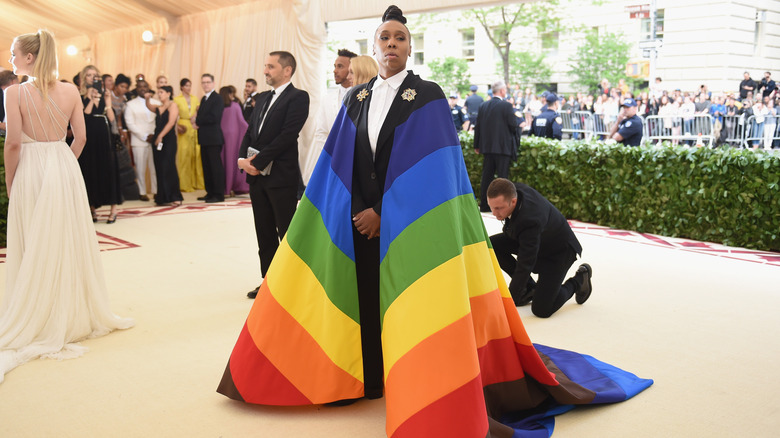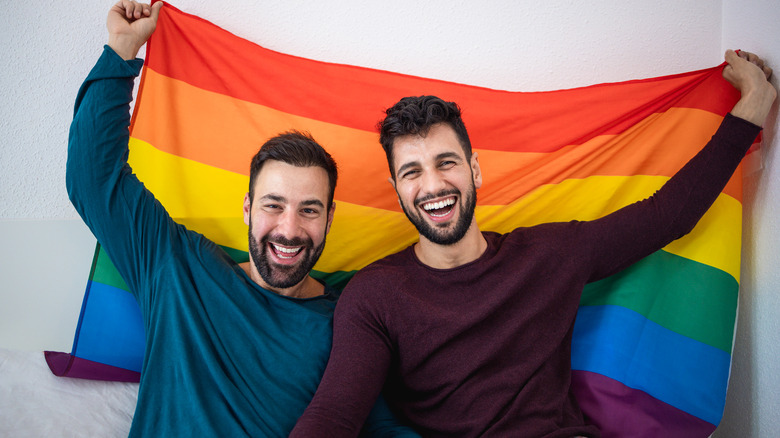The Truth About The Rainbow Flag
Every year in June, cities around the world celebrate LGBTQ+ pride in commemoration of the Stonewall Riots of 1969. During this time, in particular, you can see many rainbow flags being displayed and waved. The traditional rainbow flag has represented the pride of the LGBTQ+ community for over 40 years. Since its inception, it has inspired a number of adapted flags that have stripes to represent groups within the LGBTQ+ community at large, including an Ally Pride flag for supporters.
The rainbow has become a symbol for LGBTQ+ pride and support. The designer, Gilbert Baker, knew that a rainbow was the natural choice. On the his website, he wrote, "The rainbow came from earliest recorded history as a symbol of hope. In the Book of Genesis, it appeared as proof of a covenant between God and all living creatures. It was also found in Chinese, Egyptian and Native American history."
The flag serves as a symbol of a human rights movement, and the story of the rainbow flag is steeped in pride but also at the center of controversy. Groups around the world continue to battle over the right to fly the flag. As the rainbow flag continues to become ubiquitous through social media and retail accessibility, it is simultaneously being banned and hidden away in certain circles. Let's look at the truth about the rainbow flag.
The rainbow flag was first flown in 1978
The rainbow flag has increasingly gained popularity since its official adoption in the 1990s, but it has been a symbol of LGBTQ+ pride since it was created in the 1970s. The flag was created in 1978 by artist Gilbert Baker at the request of openly gay politician Harvey Milk (via Britannica). Baker said Milk conveyed a very strong message of visibility. "Our job as gay people was to come out, to be visible, to live in the truth as I say, to get out of the lie," Baker recalled in an interview with the Museum of Modern Art (MoMA).
Baker was asked to create a symbol for the gay community and chose to make a flag, which was Baker's idea of a powerful symbol of pride. "A flag is different than any other form of art. It's not a painting, it's not just cloth, it is not a just logo — it functions in so many different ways," Baker told MoMA. According to NPR, about 30 volunteers constructed two flags at a gay community center with an appointed budget of $1,000. The flags were first used in a San Francisco Gay Freedom Day Parade on June 25, 1978.
When the rainbow flag was officially adopted as the symbol of pride in 1994, Baker made a mile-long rainbow flag to commemorate the 25th anniversary of the Stonewall riots and it had to be carried by 5,000 people (via Oprah Daily). Baker passed away in 2017, but left a lasting impact of pride on his beloved community (via NPR).
Each color of the rainbow flag has a special meaning
Creating the first pride flag took 1,000 yards of muslin, 100 pounds of ash and salt, and 10 pounds of natural dye (via Travel & Leisure). There are six colors on the traditional rainbow flag, and each color has a deeper meaning, according to VeryWell Mind.
The top stripe of the rainbow flag is red and symbolizes vitality. The red color can be tied to the ideas of our blood and passion. The second stripe is orange, which symbolizes healing. The third stripe is yellow to represent sunlight. In newer descriptions of the colors, yellow is represented as new ideas, which can be tied to the idea that sunlight brings new life. The fourth stripe is green to symbolize a connection to nature, a place where people go to find healing and solace. Green can also represent prosperity in newer flag descriptions. The fifth stripe is indigo, sometimes described as blue, and the color symbolizes harmony and serenity. Blue is often thought of as a calming color. The sixth stripe is violet, which represents spirit. The journey to live as yourself with great pride is a truly spiritual journey, represented by the purple on the flag.
The colors of the flag have changed over time
The rainbow flag was initially designed to feature eight colors. However, the hot pink (meant to represent sexuality) and turquoise (symbolizing art and magic) stripes were cut due to the cost of dye and production at the time.
In the 1980s, activists added a black stripe to the bottom of the traditional rainbow flag to give visibility to those who had lost their lives to the HIV/AIDS crisis of that decade. This iteration of the flag is known as the "Victory Over AIDS Flag" (via Ending HIV).
In 2017, the city of Philadelphia redesigned a new pride flag with eight stripes. The flag is referred to as the "More Color, More Pride flag" and features one black and one brown stripe at the top. The black stripe symbolizes diversity and the brown stripe represents inclusivity. The flag gets its name from a Philadelphia Office of LGBT Affairs campaign to be more inclusive of intersectional communities that are often unheard and underrepresented, such as people of color in the LGBTQ+ community.
Additionally, in 2018, designer Daniel Quasar created the Progress Pride flag to be more inclusive of transgender issues and visibility. The flag shows the transgender symbol on the traditional pride flag along with the additional brown and black stripes to represent people of color. The Progress Pride flag has quickly become the popular choice because of its inclusive style.
The rainbow flag has been at the center of controversial battles
The first known legal battle involving the rainbow flag took place in December 1988, when John Stout sued for the right to display the rainbow flag on his balcony, according to Los Angeles Times. Stout's landlords banned him from displaying the flag on his West Hollywood apartment balcony, and the two parties agreed on an out-of-court settlement. The lawsuit news put the rainbow flag on the world stage as a symbol for queer pride and power.
Flying the flag on private property has been a source of dispute in multiple instances. Private property owners have battled against neighborhood associations, religious groups, and the media, according to GLBTQ. Some municipalities, towns, and school districts display the rainbow flag, but not all. Some elected officials feel the flag is a political symbol and continue to side with outspoken opponents of the flag.
In Utah, an LGBTQ+ group working to raise money by selling rainbow flags for yards had mixed news from the experience. "A number of people found their flags torn or written on or even lit on fire, which I think speaks to a more emboldened hatred," Project Rainbow founder Lucas Horns revealed to NBC News. "But with that said, more people signed up for flags than ever before and were more excited about showing love and support to the LGBTQ+ community than ever."
The rainbow flag inspired pride flags for every group in the LGBTQ+ community
Since the design of the original rainbow stripe flag, each smaller queer community within the LGBTQ+ community has designed a flag for representation. Michael Page was the first to do so by designing the three-striped bisexual flag in 1998. Then, Monica Helms, a transgender artist, designed the Transgender Pride flag, which debuted in 2000 (via WeHoville).
This first adaptation has inspired countless other flags to show support and identity for the smaller subsets of communities such as genderfluid, pansexual, intersex, and non-binary, for example (via Seventeen). The LGBTQ+ community is a large and diverse group and it has become increasingly important for smaller groups to find a place within the larger community, and the flags are an easy way to identify others. Some of the bigger cities that support large and thriving LGBTQ+ communities, like Philadelphia, have adopted their own versions of the original pride flag.
The original pride flag is on display in a San Francisco museum
After artist Gilbert Baker designed the iconic piece, two flags were produced and flown at the San Francisco Gay Freedom Day Parade, after which the flags went separate ways. One was stolen and never recovered and the other was poorly stored for two decades and suffered water damage, according to Smithsonian. Baker kept a fragment of the original flag safe until he passed away in 2017. Baker's sister then gave the 10- by 28-foot fragment to Gilbert Baker Foundation President Charley Beal. Neither Baker's sister nor Beal knew the flag's origin story and Beal used the flag for a 2019 New York Pride Parade.
Beal kept the flag safe but eventually had it analyzed in 2020. When he learned that it was the first flag, he arranged to pass it on to the GLBT Historical Society Museum in San Francisco where it is now on permanent display (via Smithsonian). The historical society's executive director Terry Beswick told the Los Angeles Times what it means to connect the original rainbow flag to the world. "It creates safe space, and it is a political statement," he explained. "It has been an emblem of our movement, but it has also propelled the movement forward, and given people a vision of what it could mean to be an inclusive society that doesn't oppress us, that doesn't force us down in dark corners, and allows us to be colorful and free and fabulous."
There were other symbols of gay pride before the rainbow flag
Prior to the design of the rainbow flag, there were other symbols that were associated with the LGBTQ+ community in smaller circles. In the 1970s, the Gay Activists Alliance used the Greek symbol lambda, and a purple hand had been adopted as a sign of protest in San Francisco (via Them). According to the Eastern Illinois University Center for Gender and Sexual Diversity, the labrys has been used as a lesbian symbol, and a lavender rhino was used as symbol of protest in the 1970s.
Inverted pink and black triangles are also sometimes used as symbols in the LGBTQ+ community. However, Nazis used the inverted triangles as a means of identification to persecute or exterminate them. In the 1970s, many people in the LGBTQ+ community were not comfortable adopting the triangle as a symbol of gay pride due to its dark history. "It came from such a horrible place of murder and holocaust and Hitler. We needed something beautiful, something from us," rainbow flag designer Gilbert Baker said (via Museum of Modern Art).
Despite the original meaning, the inverted triangles have been reclaimed by some in the LGBTQ+ community and are displayed with pride or as a symbol of protest in places where gay people are still persecuted (via Time).
The rainbow flag has been banned in some locations
According to Gallup, 70% of Americans think gay marriage should be recognized as valid by the law. Even though a large majority of the country supports same-sex relationships, the minority continues to make waves and propose policies against gay rights, including banning the rainbow flag.
The rainbow pride flag has been placed in the center of the political landscape, and opponents of it like to use it as an example of a "gateway" flag, meaning if a rainbow flag is allowed, other groups can protest to have their flag flown, too. The Carroll County, Maryland school board used this argument to ban the pride flag in April 2022 (via Los Angeles Blade).
Pride flags have also been banned as a political symbol in four other states (via The 19th). The continuing argument circles around the concepts of identity versus ideology, and being queer is often mistakenly categorized as a political ideology. Opponents of the rainbow flag can compare it to flying the Confederate flag to justify making a blanket ban that limits all representation.
The energy company Exxon announced that it will no longer fly a pride flag outside of the company headquarters during the month of June. Even though the company had flown the pride flag the previous year, the leadership wanted to eliminate "external position flags" and display neutrality on all political issues (via Time).
From runway to retail, the rainbow flag is making fashion history
As support for the LGBTQ+ community has grown, the rainbow flag has entered the high fashion and retail spaces. Writer Lena Waithe showed up to the 2018 Met Gala red carpet draped in a rainbow flag cape. It was an especially pointed choice because the theme for that year's Gala was Catholicism (via Harper's Bazaar).
In 2018, Vogue UK featured a story about the abundance of rainbow patterns seen on the runway from designers like Burberry, Missoni, Dolce & Gabbana, Marco de Vincenzo, Versace, and Ashish. Hannah Craggs, editor of WGSN, pointed out that the bursts of color were likely inspired by the political and social climate of the world at the time. "When faced with a chaotic political and social landscape, escapism and play is the logical response. Nothing symbolises this better than the rainbow flag," said Craggs.
The rainbow flag is making its way to retail, too. In 2022, Target launched collaborations with two queer-owned, female-founded brands — TomboyX and Humankind — to offer gender-affirming clothing lines that feature swimsuits and specialty undergarments like compression tops and packing briefs in rainbow-inspired prints. Customers are happy to see that LGBTQ+ youth can shop in-person at a big box store for clothing items that are sometimes difficult for them to access (via Bustle).
The rainbow flag is being accepted and raised in new places
The rainbow flag has also come under fire from the nation's hightest office. Under the Trump administration, U.S. embassies and consulates were banned from flying anything other than the American flag. However, in 2021, President Biden overturned the ban, and pride flags were flown once again outside U.S. buildings in June 2021 (via ABC News).
While some towns and school districts are fighting to keep the rainbow flag down, other municipalities are welcoming the rainbow flag for the first time. In 2019, the state of Wisconsin flew the rainbow flag at the capitol building for the entire month of June. Governor Tony Evers' executive order read: "Publicly displaying the Rainbow Pride Flag sends a clear and unequivocal message that Wisconsin is a welcoming and inclusive place where everyone can live without fear of persecution, judgment, or discrimination." In 2021, the city of San Diego raised the pride flag at City Hall. Mayor Todd Gloria said at the time, "The rainbow flag flying proudly at city hall for the first time sends an important message to our LGBTQ community: we see you, we support you and you belong here" (via KPBS).
The rainbow flag has come to represent visibility and truth, which the San Francisco AIDS Foundation says is necessary for a healthy democracy. Although the flag is connected to the LGBTQ+ community and its history, the rainbow flag is also a reminder to the world to create a space for everyone.
